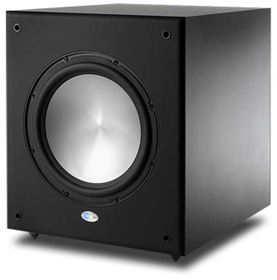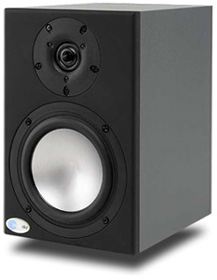 Blue Sky Sky System One 2.1
Subwoofer/Satellite Speaker System Blue Sky Sky System One 2.1
Subwoofer/Satellite Speaker System
The idea behind Blue Sky’s Sky System One 2.1 is
fairly simple. Blue Sky cofounder Pascal Sijen and his partners wanted to create a studio
monitor system capable of fully reproducing modern recordings. To their minds, this meant
sealed-box speakers (for their superior reproduction of transients), a large subwoofer
capable of handling frequencies down to 20Hz, and bass management to direct the high
frequencies to the satellites and the lows to the sub.
Originally, the System Ones were intended for use only as a
studio monitor system, but along the way, Blue Sky discovered that they could serve
equally well as high-quality speakers for the home. Which was where I listened to them.
Description
The Sky System One 2.1 ($2195 USD) comprises two SAT 6.5
Mk.II active satellites and one SUB 12 active subwoofer. Yes, active: each
enclosure includes built-in amplification. In fact, the SAT 6.5 Mk.II, which measures
12"H by 8"W by 10"D and weighs a robust 28 pounds, has two 100W
amplifiers: one each for its mid-woofer and tweeter, each amp’s response tailored to
provide the flattest possible driver output. The 6.5" long-excursion woofer has a
1.5" voice-coil and a mica-filled polypropylene cone with a rubber surround. The
tweeter is a 1" dual-concentric design with a ferrite magnet. On the rear of the
speaker are an Input XLR connector and controls for Gain and Power, as well as a fuse and
IEC power connection. The rest of the satellite’s rear panel is occupied by a
heatsink for cooling the amplifiers.
 The SUB 12 subwoofer is the size of a
trunk (18"H x 15"W x 20"D) and weighs 62 pounds. Its 12" driver is
powered by a 200W amplifier, again with frequency shaping to result in flat response. As
in most sat-sub systems, the subwoofer is the point of interconnection. On its rear are
six XLR connectors that accept the left and right signals, the left and right connection
to the satellites, and the sub-in/sub-out connections that allow daisy-chaining of the SUB
12. Other controls on the rear of the SUB 12 include Auto Mute (which mutes the output
when no signal has been received for 15 minutes), Phase, Gain, and Power, as well as a 4A,
slow-blow fuse and an IEC power connection. The SUB 12 subwoofer is the size of a
trunk (18"H x 15"W x 20"D) and weighs 62 pounds. Its 12" driver is
powered by a 200W amplifier, again with frequency shaping to result in flat response. As
in most sat-sub systems, the subwoofer is the point of interconnection. On its rear are
six XLR connectors that accept the left and right signals, the left and right connection
to the satellites, and the sub-in/sub-out connections that allow daisy-chaining of the SUB
12. Other controls on the rear of the SUB 12 include Auto Mute (which mutes the output
when no signal has been received for 15 minutes), Phase, Gain, and Power, as well as a 4A,
slow-blow fuse and an IEC power connection.
Because the Sky System One 2.1 speakers are powered, you
don’t connect them to the speaker outputs of a power amplifier. The System One 2.1 is
connected directly to a preamplifier, or the preamp outputs of a receiver or integrated
amp.
System
I used the System One 2.1 with my primary audio setup,
which consists of a Dual CS-5000 turntable with Grado Gold cartridge, a Sony X-303ES CD
player, a Magnum Dynalab Etude FM tuner, and an Akai GX-620 reel-to-reel tape deck. These
feed a Linn Majik-1P integrated amplifier that drives my NEAR 50-Me Mk.II speakers via
biwired 14-gauge AR speaker cable. The NEARs are tall, floorstanding speakers with an
8" woofer and a 4" midrange, both with metal-ceramic cones, and 1" titanium
tweeter. They were reviewed
in SoundStage! in 1997; they’ve since been discontinued.
This, my long-term reference system, now resides in a newly
rebuilt room measuring 17’L x 11’W x 7’H. The renovation included extra
insulation in the walls, a cork floor, and dedicated, surge-protected AC sources.
To permit direct comparisons of the Linn-NEAR and Blue Sky
systems, I rigged up an old RadioShack connector box for an outboard tape deck by running
Straight Wire interconnects from the Linn’s Preamp Out jacks, and more Straight Wire
interconnects back to the Linn and to the System One sub. (The interconnects to the System
One were Straight Wire’s Symphony II, loaned specifically for this review by Straight
Wire. The ones from and to the Linn amp are mine; I’ve had them so long I can’t
remember their name.)
I set the SAT 6.5 Mk.IIs atop 24"-high PSB speaker
stands, secured with a little Blu-Tack. They ended up about 5’ apart, 5.5’ feet
from my listening chair, and about 30" out from the front wall. On either side of
them I placed the NEAR speakers, which ended up about 6’ apart. The sub was placed
between the two satellites.
The final stage of setup was to calibrate the Sky System
One 2.1 using .wav files downloaded from Blue Sky’s website. The detailed online
instructions, which call for the use of a sound-pressure-level (SPL) meter such as those
available from RadioShack, are mainly designed for use in studios, not a living room. Even
so, it took me less than 30 minutes to set up everything to my satisfaction.
Sound
I used Blue Sky’s Sky System One 2.1 for some time
before sitting down to listen critically, but even early on, I heard -- and felt -- the
system’s incredible bass extension. After about 50 hours of break-in, I ran a test CD
through the System One and then the Linn-NEARs to check the systems’ frequency
responses. The NEARs were down several dB at 31.5Hz, although I could still hear some
output. The System One, on the other hand, was strong down to the 20Hz bottom limit of the
tones -- just the thing for Saint-Saëns’s "Organ" Symphony.
 How well a speaker reproduces the
human voice is important to me, so I began my critical listening with a series of
vocalists. "This Can’t Be Love," from Diana Krall’s Stepping Out:
The Early Recordings (CD, GRP GRD-9425), evinced what I heard generally throughout the
review period: the Sky System One 2.1 had less midrange output than the NEARs. This tended
to make Krall’s voice sound a bit more distant through the Blue Skys, much more
up-front through the NEARs. In fact, the difference was almost extreme. After listening to
the NEARs for a while, I’d switch to the Blue Skys and think, "Wow! Where’s
the midrange?" Then, once I’d become accustomed to the Blue Skys, I’d
switch back the NEARs and think, "Whoa! Too much midrange!" How well a speaker reproduces the
human voice is important to me, so I began my critical listening with a series of
vocalists. "This Can’t Be Love," from Diana Krall’s Stepping Out:
The Early Recordings (CD, GRP GRD-9425), evinced what I heard generally throughout the
review period: the Sky System One 2.1 had less midrange output than the NEARs. This tended
to make Krall’s voice sound a bit more distant through the Blue Skys, much more
up-front through the NEARs. In fact, the difference was almost extreme. After listening to
the NEARs for a while, I’d switch to the Blue Skys and think, "Wow! Where’s
the midrange?" Then, once I’d become accustomed to the Blue Skys, I’d
switch back the NEARs and think, "Whoa! Too much midrange!"
The systems’ high-end responses were fairly similar:
highly detailed, smooth, and extended. The Sky System One 2.1, as noted above,
consistently outperformed the NEARs at the low end of the spectrum, but that was part of
the design brief for the Blue Skys: extended, flat bass response.
One song that really revealed the differences was "You
Can Call Me Al," from Paul Simon’s Graceland (CD, Warner Bros./Rhino R2
78904). The Sky System One 2.1 excelled at bass slam -- the reproduction of highly
rhythmic sounds such as electric bass runs and kick drums. This track has many such
sounds, especially the bass run in the bridge, and the Blue Skys’ reproduction of
them was fabulous -- very tight and well defined. The NEAR 50-Me Mk.IIs, on the other
hand, weren’t quite as well controlled, and the bass wasn’t quite as tight.
Still, the NEARs really shone in their reproduction of the brass and tin whistle, and,
again, placed the vocal more at the center of the stage. Both philosophies of design have
their merits, but the more I listened, the closer the Sky System One 2.1 sounded to the
truth.
Trying to coax a bit more midrange from the Sky System One,
I shifted the satellites’ positions: closer to the front wall, then farther away;
toed in, then not toed in; sitting closer to them, then farther away. I concluded that
their sound pretty much was what it was, varying little with changes in position -- a very
good trait for a nearfield monitor. Changing the NEARs’ positions to reduce their
overly enthusiastic midrange response proved pretty fruitless. Pointing them straight
ahead instead of toeing them in reduced the mids, but reduced the highs even more --
proportionately, the midrange was still just as much in my face.
Another track that showed up the differences between the
NEAR 50-Me Mk.II and the Sky System One 2.1 was Manhattan Transfer’s performance of
Weather Report’s "Birdland," from The Manhattan Transfer Anthology: Down
in Birdland (CD, Atlantic D200146). Janis Siegel’s lead vocal sounded warmer
through the NEARs, more in line with what I’ve experienced hearing ManTran in
concert, and the group’s sound was presented with more blending of the voices. But
Tim Hauser’s lead vocals sounded honky, a bit as if Hauser had a cold. The Sky System
One 2.1 sounded cooler -- voices were a bit recessed in comparison, although the
"slam" of ManTran’s largely synthesized accompaniment was spectacular, and
the soundstage that much more precise.
Conclusion
After listening seriously for about ten hours over three
days, I concluded that the NEAR 50-Me Mk.IIs offered more warmth, while Blue Sky’s
Sky System One 2.1 provided precision in spades. In the end, the choice will depend on
what you want. The Sky System One offered the most precise, most detailed sound I’ve
ever heard, and would probably be magnificent as a studio monitor system, which is what it
was designed to be. The Blue Skys offer exceptionally refined sound and incredibly
extended frequency response. With many tube preamps, they’d probably pick up the
slight bit of midrange warmth I feel they need to be exceptional home speakers. But even
with this caveat, and no matter what your gear, the Sky System One 2.1 deserves a critical
listen.
. . . Thom Moon
Price of equipment reviewed
|